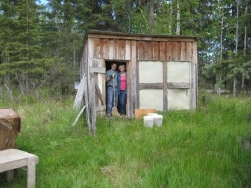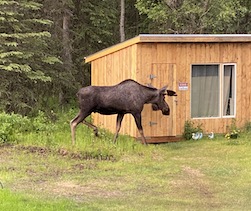In Prescription for Adventure: Bush Pilot Doctor and From Kansas Wheat Fields to Alaska Tundra you read about Doc and Ruby getting in on the last Homestead Act in Alaska, in 1961. Eighty acres was theirs for the taking. All they had to do was "prove up." The requirements varied, but most followed the procedures for earlier homestead patents in Oklahoma, Nebraska, and other such sunlit, prairie-sod states:
- Clearing a percentage of the land.
- Building a primary residence and living in it continuously for several years.
- Planting a harvestable crop.
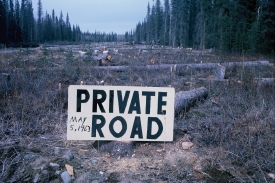
"Proving up" the Homestead
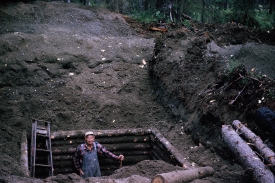
Solomon Leppke Digging a Septic Crib
On the Kenai Peninsula, the requirement of clearing 8 percent of the land was difficult enough, given the terrain was that of dense black spruce forests with mossy floors and criss-crossed windfall; but, the factor that stumped many homesteaders — and the officials who monitored such guidelines — was planting a harvestable crop: the cool growing season of midnight sun was perfect for root crops, but truncated for what was typically considered "harvestable," that of grass and grains. One homesteader got away with planting potatoes.
Energy couldn't be wasted with experimenting, trying to evade the stipulations, or using up the designated three years to prove up. Doc and Ruby matched their lifestyle needs and the proving up process; thus, clearing a half-mile long airstrip and planting oats and then timothy hay on the elongated pasture. Building one residence wasn't enough. They built a log cabin, primary residence, hangar, woodshed, and A-frame. Later, another hangar was added, along with a chicken coop.
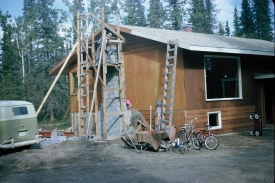
Building the Main House
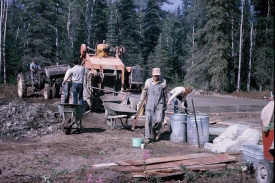
Solomon Leppke and Others Pouring the Hangar Slab
In the 1980s, Doc purchased an additional 33 acres; nevertheless, the entire Gaede homestead is referred to legally as "The Gaede (gay-dee) Eighty Subdivision."
A number of years have passed since the 1960s when the buildings were freshly painted and the airstrip groomed. What have been the effects of 40-some years of below zero weather, drizzly rain, squirrels, below-code electrical wiring, heavy snow loads on roofs, rotting logs, and the wilderness's determination to reclaim any cleared space? What have been successive improvements? What has become of the airstrip and buildings?
The Old Hangar, built in the early 1960s become hazardous to the airplanes which sought refuge.
The cabin's longevity was interrupted by a fire. (Read more below)
The half-mile Gaede Eighty airstrip is noted on aviation maps as "Gaede Private."
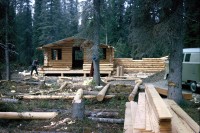
An Athabascan Indian, Johnny Parks, built the cabin, and many others in the area, during the early 60s. He was a short man, who built short walls, and short door frames. The Gaedes on the Eighty have never been tall people, but barely 6 foot outer walls and even lower door frames gave everyone a head-knocker or two!
Naomi's mother, Ruby Gaede named the cabin "Elisha's Inn," after the story in I Kings 4:8-10, where a couple built a small room for Elisha to stay in when he came through their country.
For the homestead cabin Open House, Ruby Gaede sketched a rendering of the cabin on the invitation:
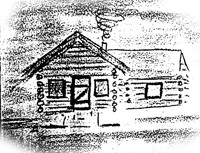
Open House at
"Elisha's Inn"
October 27, 1963
2:00 - 5:00 pm
This image is now used as the with-in chapter dividers in Prescription for Finding Home in Alaska.
Since 1963, the Gaede-Eighty homestead cabin has been a landmark for the Gaede family and many others who have made sojourned there. In the fall of 2005, a fire started in the basement. The interior was burned, water-damaged, and/or charred. Given that the logs served as the interior and exterior of the building, this piece of history is no longer inhabitable.
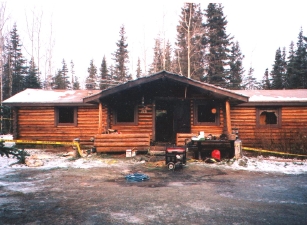
Burned in 2005
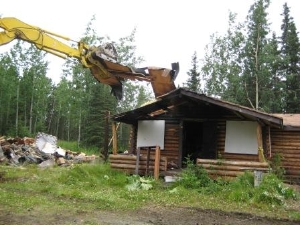
Demolition of Cabin
After much deliberation, exploration of options, changes in plans, and gasps at demolition and construction costs, Naomi and her siblings decided to demolish the old structure. Parting with this landmark and family history seemed unbearable. On August 2, 2007, the cabin was demolished.
Then the thought of saving a section of the cabin popped into Naomi's head! The original bedroom at one end was the least damaged. But, would it be unscathed during the demolition AN D relocated to the side of the cabin site? Shawn Holly of River City Construction and Bill Hill of Oilfield Hot Shot Service put their heads and expertise together. Yes, it was possible, but they didn't know if it would hold together after being cut loose from the mid-section or if the floor would be strong enough to support the walls and roof while being moved.
On August 6, 2007, the bedroom-turned-mini-cabin was lifted off its foundation and successfully dragged to a corner of the cabin lot!
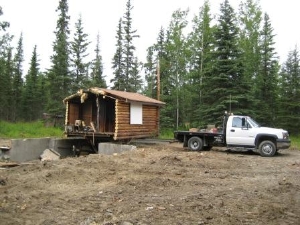
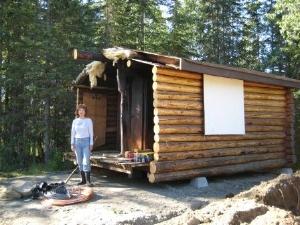
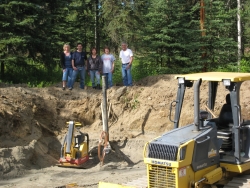
The remaining hole was cleaned up and prepared for the foundation.
In the fall of 2007, construction began on the new cabin. The design was much like the first one, with a bedroom on each side of the main section, 860 square feet, and a low pitch trapper-style roofline. As much as nostalgia influences decision, there were changes: eight-foot walls, a full-size basement, and operable windows.
In the spring of 2008, Naomi discovered 4-6 inches of water in the basement! Construction was halted to deal with this most distressing and disappointing dilemma. In June, the long process of re-construction began.
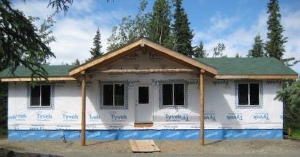
2008
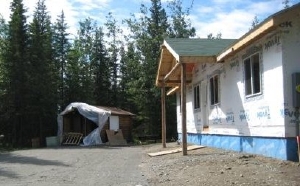
2008
On July 7, 2009, Naomi found the main floor of the cabin suitable for living — electricity, appliances, running water. Water problems continued in the mechanical room. These were deemed as a "rain forest" cycle of condensation from the extremely cold Alaskan well water.
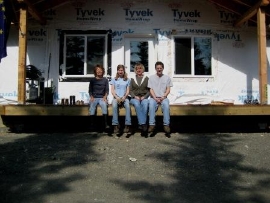
Naomi, Kenya, Patti, and Mark on the porch
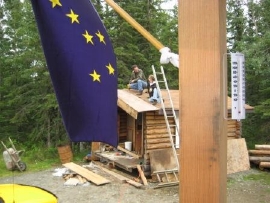
Mark and Kenya on the Roof of the "Mini-Cabin"
During this time, the salvaged bedroom of the original cabin, which is now referred to as "the mini-cabin," was winterized to protect it until restoration is possible.
In the fall of 2009, the cabin was sided and looked like a "real" cabin!
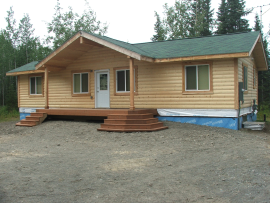
August 2009
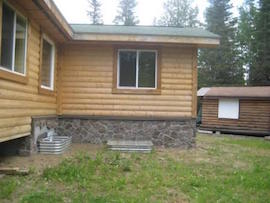
Rock work finished off the bottom area of the cabin. (2012)
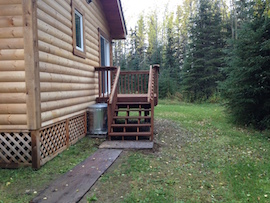
A back porch ad front railings were added per Final Inspection permit. (2014)
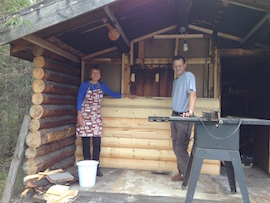
The mini-cabin was restored to usefulness. (2014)

Merry Christmas! (2014)
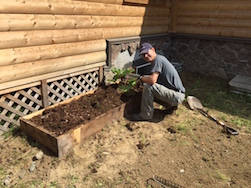
Constructing a rhubarb box. (2015)

Flower Box (2015)
In 2018, the logs were refinished and the front door was painted forest green. An address sign was also added: 34085 Gaede Lane. At this time, the Johnny Park's remnant cabin was also re-stained.
In 2019, inside the cabin, Ruby Gaede (Mom's) Moose was put up, along with Alaska animal heads and skins that Mark had shot.

"Last Wednesday night he took me out and we spotted a bull just across the river from this village so we landed on a sandbar and found ourselves in a bit of soup as the sand was not dry enough but we ignored that and hiked to find the moose..." wrote Ruby Gaede (Mom). (Read the entire story)

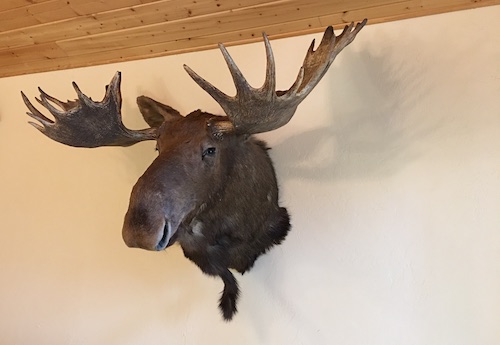
The prescription for Gaedes thriving in Alaska is a generous dose of airplanes and flying. Doc was bit with the flying bug in Anchorage, Alaska, 1956, when he took float planes lessons at Lake Hood. His son, Mark, grew up in the backseat of his father's airplanes and took over the controls before soloing age of 16. Naomi married a man with a private pilot's license — who flew his Cessna 210 from Denver to Alaska, and then into Interior Alaska and Barrow. Doc's second daughter, Ruth, married an A&P mechanic who started Rupp Aircraft Services on the Gaede-80 airstrip; in addition, he builds experimental airplanes.
The question has been asked, "Are any of the Gaede women pilots?" The answer, "The men fly, and the women pray." That's not the entire truth: Naomi's daughter, Nicole, holds a private pilot's license.
Mark continues to be "one" with his Super Cub. Nothing gives him greater satisfaction than to take off and land on that narrow half-mile airstrip.
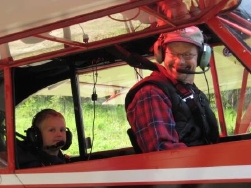
Nevan with his Papa Mark
in the Super Cub
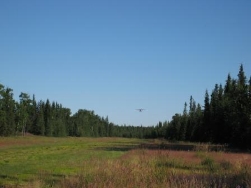
Mark taking off on Gaede-80 Private
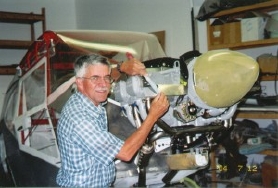
Roger, Ruth's husband, uses the airstrip for his aviation repair business: Rupp Aircraft Service. As though it isn't enough to spend time in his hangar repairing aircraft, he has spent discretionary time building a Rutan-designed Defiant, a Stolp Starduster Too, and a RV-6.
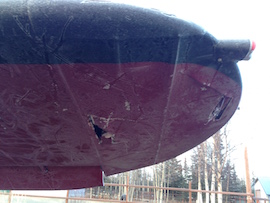
A bull moose in rut took on an airplane parked on the Gaede airstrip — waiting for repairs. (Nov. 2014)
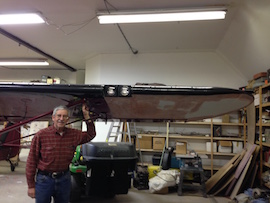
Airplane wing after Roger repaired it.
(The moose created more work for Roger!)
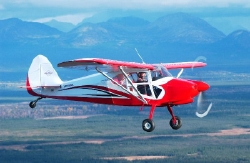
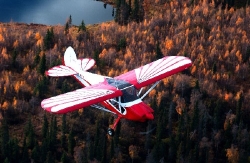
Then, like a stray dog abandoned in the country, an un-airworthy 150 Piper PA-22 150 Tri-Pacer found its way onto the Gaede 80 airstrip in front of Roger's shop and sat there for several years. After awhile, Roger started imagining modifications for the old critter, and the rest is a Cinderella story of The Ruppe Racer! Some of the alterations included:
- Piper cowling replaced with a van's RV-6 cowling and subsequent remodel of the firewall
- Spring aluminum landing gear, versus the Cessna type of spring steel
- Windows
- Engine modification to incorporate a Dynafocal engine mount
- Vortex generators on the wings to reduce stall speeds
It took about 1,500 hours to rebuild this airplane? During the remodel of the Ruppe Racer, Roger used the door lock and latch assembly from Doc Gaede's Cessna 180? That was the plane Doc crashed into the homestead chicken house in 1984? (Read about this drama in Chapter 23 of Prescription for Adventure: Bush Pilot Doctor.)
The side of the fuselage was conceptualized by Guff Sherman of Sherman Signs and modified by Roger to show the scalloped shape on the nose. The scallop of the nose mirrors the scallop on the bottom of the wings. The stripes are intentionally swooped to keep them from being cut into by windows. As is apparent, the tops of the wings mimic those of a bird. The nose could be called a Rudolph design because of all the red. The overall theme is a retro mix of modern and nostalgia.
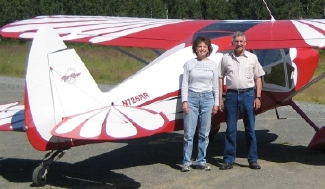
Naomi and Roger leaving for Seldovia, AK
Elmer Gaede (Dad) built a hangar in 1967. In 1985, another hangar was purchased from Dr. Paul Isaak and reassembled. Eventually, the first hangar became a hazard, It was taken down in 2008. The experience was not unlike an archeological dig with exclamations among siblings of, "Oh! Remember when..."
In the process, 15 old batteries, tires, petrified rocks, Blazo boxes, bent airplane propeller, old toboggan, kerosene lamps, freeze-dry food, assorted medical equipment, stacks of corrugated tin, and other discoveries were made; and subsequently there was much story-telling and laughter.
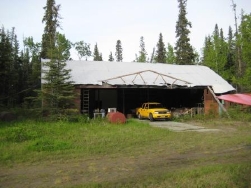
Pick-up in the Old Hangar (1999)
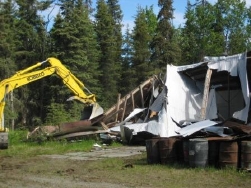
Taking down the Old Hangar (1999)
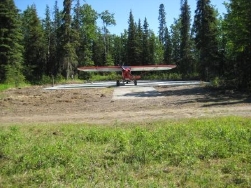
Mark's Super Cub on the Remaining Hangar Pad (1999)

Naomi Cleaning up a Forest of Old 55-gallon Oil Drums (1999)
The concrete pad of the original hangar was still useable, so in 2020, Mark decided to rebuild a hangar on that clean surface. (The second hangar had a dirt/silt/sand floor and to walk on it with wet boots or drive on it with damp tires was like rolling fried chicken in flour before cooking.)
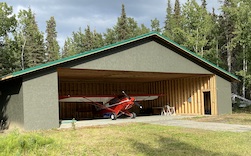
In 2019, Mark rebuilt the Chicken Coop — for structural purposes. He reused the original siding to maintain its historical integrity. Naomi sent up a sign and chickens. A curious homestead moose gave it approval.
